A Multifaceted Exploration of Atmospheric Turbulence and Its Impact on Optical Systems: Structure Constant Profiles and Astronomical Seeing
Abstract
:1. Introduction
2. Finite-Dimensional (Parametric) Model
2.1. AFGL (Dewan)
2.2. Marzano
2.3. Trinquet–Vernin (TV)
2.4. Pamela
3. Optical Parameters in Astronomy
3.1. Fried Parameter
3.2. Seeing
4. Data and Validation
Matlab Simulation of and Seeing in Redu
5. Conclusions
Author Contributions
Funding
Data Availability Statement
Acknowledgments
Conflicts of Interest
References
- Bekhrad, P.; Ivanov, H.; Leitgeb, E. Car to X Communication with Optical Wireless as Support and Alternative to RF-Technologies for Roads and Future Transportation. In Proceedings of the IEEE 26th International Conference on Software, Telecommunications and Computer Networks (SoftCOM), Split, Croatia, 13–15 September 2018. [Google Scholar]
- Majumdar, A.K. Advanced Free Space Optics (FSO): A Systems Approach, 1st ed.; Springer: New York, NY, USA, 2015. [Google Scholar]
- The Radio Refractive Index: Its Formula and Refractivity Data. Available online: https://www.itu.int/dms_pubrec/itu-r/rec/p/R-REC-P.453-11-201507-S!!PDF-E.pdf (accessed on 1 January 2023).
- Bean, B.R.; Dutton, E.J. Radio Meteorology; National Bureau of Standards: Boulder, CO, USA, 1966. [Google Scholar]
- Tatarski, V.I. The Effect of the Turbulent Atmosphere on Wave Propagation; Israel Program for Scientific Translations: Jerusalem, Israel, 1971. [Google Scholar]
- Ishimaru, A. Wave Propagation and Scattering in Random Media, Vol. 2 Multiple Scattering, Turbulence, Rough Surfaces and Remote Sensing; Academic Press: Cambridge, MA, USA, 1978. [Google Scholar]
- Dewan, E.; Good, R.; Beland, B.; Brown, J. A Model for (Optical Turbulence) Profiles Using Radiosonde Data; Phillips Laboratory: Bedford, MA, USA, 1993. [Google Scholar]
- Dewan, E.; Grossbard, N. The inertial range “outer scale” and optical turbulence. Environ. Fluid Mech. 2007, 7, 383–396. [Google Scholar] [CrossRef]
- Tatarski, V.I. Wave Propagation in a Turbulent Medium; Dover Publication, Inc.: New York, NY, USA, 1961; pp. 324–325. [Google Scholar]
- Gurvich, A.S.; Kaprov, B.M.; Tsvang, L.; Yaglom, K. Empirical data on the small-scale structure of atmospheric turbulence. In Atmospheric Turbulence and Radio Wave Propagation; Nauka: Moscow, Russia, 1967; pp. 1–31. [Google Scholar]
- Smith, F.G. Atmospheric Propagation of Radiation. In The Infrared & Electro-Optical Systems Handbook; SPIE Press: Bellingham, WA, USA, 1993; Volume 2, pp. 1–332. [Google Scholar]
- D’auria, G.; Marzano, F.S.; Merlo, U. Model for estimating the refractive-index structure constant in clear-air intermittent turbulence. Appl. Opt. 1993, 32, 2674–2680. [Google Scholar] [CrossRef] [PubMed]
- Bekhrad, P.; Leitgeb, E. Different models of the refractive index structure constant calculation. In Proceedings of the IEEE 3rd West Asian Symposium on Optical and Millimeter-Wave Wireless Communications (WASOWC), Tehran, Iran, 24–25 November 2020. [Google Scholar]
- Marzano, F.S.; d’Auria, G. Model-based prediction of amplitude scintillation variance due to clear-air tropospheric turbulence on Earth-satellite microwave links. IEEE Trans. Antennas Propag. 1998, 46, 1506–1518. [Google Scholar] [CrossRef]
- Ishimaru, A. Wave Propagation and Scattering in Random Media, Vol 1: Single Scattering and Transport Theory; Academic Press: Washington, DC, USA, 1978. [Google Scholar]
- Vasseur, H. Prediction of Tropospheric Scintillation on Satellite Links from Radiosonde Data. IEEE Trans. Antennas Propag. 1999, 47, 293–301. [Google Scholar] [CrossRef]
- Trinquet, H.; and Vernin, J. A statistical model to forecast the profile of the index structure constant . Environ. Fluid Mech. 2007, 7, 397–407. [Google Scholar] [CrossRef]
- Giordano, C.; Vernin, J.; Trinquet, H.; Munoz, C. Weather Research and Forecasting prevision model as a tool to search for the best sites for astronomy: Application to La Palma, Canary Islands. Mon. Not. R. Astron. Soc. 2014, 440, 1964–1970. [Google Scholar] [CrossRef]
- Oh, E.; Ricklin, J.C.; Eaton, F.D.; Gilbreath, G.C.; Doss-Hammel, S.; Moore, C.I.; Murphy, J.S.; Oh, Y.H.; Stell, M. Estimating optical turbulence using the PAMELA model. Proc. SPIE 2004, 5550, 256–266. [Google Scholar]
- Oh, Y.H.; Ricklin, J.C.; Oh, E.; Doss-Hammel, S.; Eaton, F.D. Estimating optical turbulence effects on free space laser communication: Modeling and measurements at ARL’s A_LOT facility. Proc. SPIE 2004, 5550, 247–255. [Google Scholar]
- Ricklin, J.C.; Hammel, S.M.; Eaton, F.D.; Lachinova, S.L. Atmospheric channel effects on free-space laser communication. In Free-Space Laser Communications; Optical and Fiber Communications Reports; Springer: New York, NY, USA, 2006; Volume 2, pp. 9–56. [Google Scholar]
- Van Der Graaf, S.C.; Kranenburg, R.; Seger, A.J.; Schaap, M.; Erisman, J.W. Satellite derived leaf area index and roughness length information for surface-atmosphere exchange modelling: A case study for reactive nitrogen deposition in north-western Europe using LOTOS-EUROS v2.0. Geosci. Model Dev. 2020, 13, 2451–2474. [Google Scholar] [CrossRef]
- Hemmati, H. Near-Earth Laser Communications, 2nd ed.; CRC Press: Boca Raton, FL, USA, 2020; pp. 1–454. [Google Scholar]
- Fried, D.L. Statistics of a Geometric Representation of Wave-front Distortion. J. Opt. Soc. Am. 1966, 55, 1427–1435. [Google Scholar] [CrossRef]
- Giordano, C. Prediction et optimisation des techniques pour l’observation à haute resolution angulaire et pour la future generation de très grands telescopes. Ph.D. Thesis, Université Nice Sophia Antipolis, Nice, France, 2014. [Google Scholar]
- Kemp, E.M.; Felton, B.D.; Alliss, R.J. Estimating the Refractive Index Structure-Function and Related Optical Seeing Parameters with the WRF-ARW. In Proceedings of the 9th WRF User’s Workshop, NCAR, Boulder, CO, USA, 23–27 June 2008. [Google Scholar]
- Nelson, D.H.; Walters, D.L.; MacKerrow, E.P.; Schmitt, M.J.; Quick, C.R.; Porch, W.M.; Petrin, R.R. Wave Optics Simulation of Atmospheric Turbulence and Reflective Speckle Effects in CO2 Lidar. Appl. Opt. 2000, 39, 1857–1871. [Google Scholar] [CrossRef] [PubMed]
- Liu, L.Y.; Giordano, C. Optical Characterization at LAMOST Site: Observation and models. Mon. Not. R. Astron. Soc. 2014, 451, 3299–3308. [Google Scholar] [CrossRef]
- Bekhrad, P. Evaluation of the Refractive Index Structure Constant Profile and Seeing. Ph.D. Thesis, Graz University of Technology, Graz, Austria, 2023. [Google Scholar]
- Andrews, L.C.; Phillips, R.L. Laser Beam Propagation through Random Media, 2nd ed.; SPIE Press: Bellingham, WA, USA, 2005; Volume PM152, pp. 1–808. [Google Scholar]
- Zilberman, A.; Golbraikh, E.; Kopeika, N.S. Propagation of electromagnetic waves in Kolmogorov and non-Kolmogorov atmospheric turbulence: Three-layer altitude model. Appl. Opt. 2008, 47, 6385–6391. [Google Scholar] [CrossRef] [PubMed]
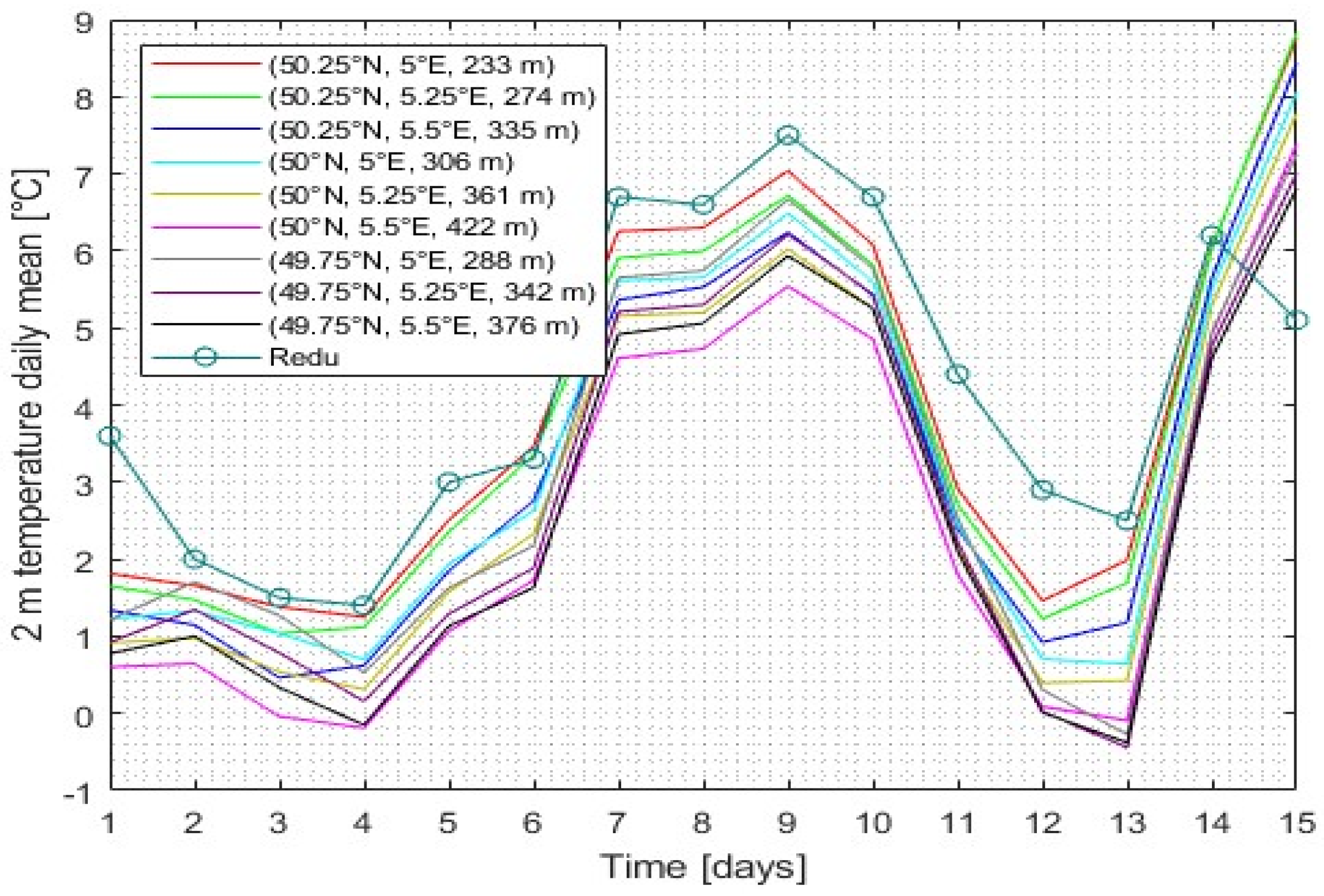



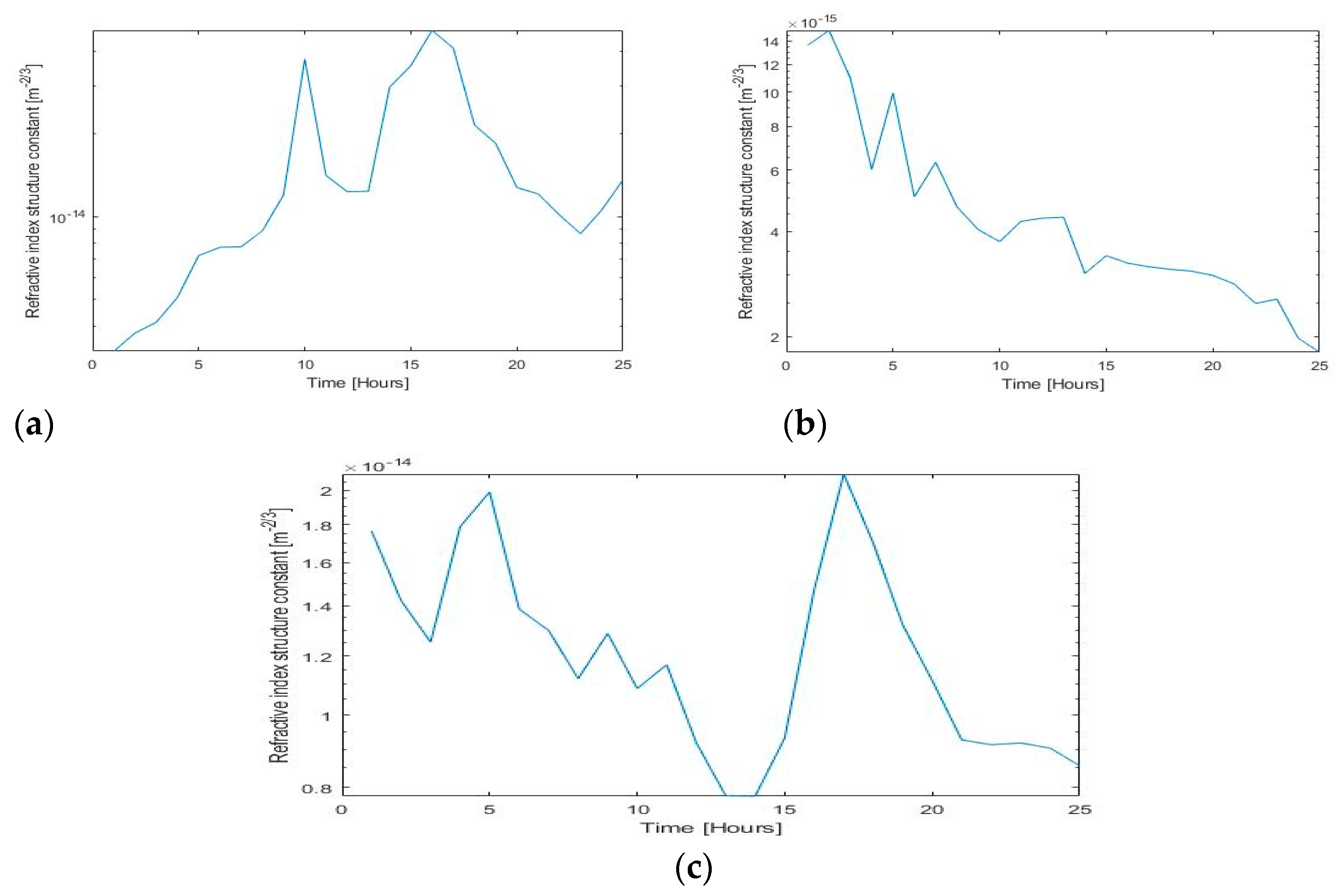
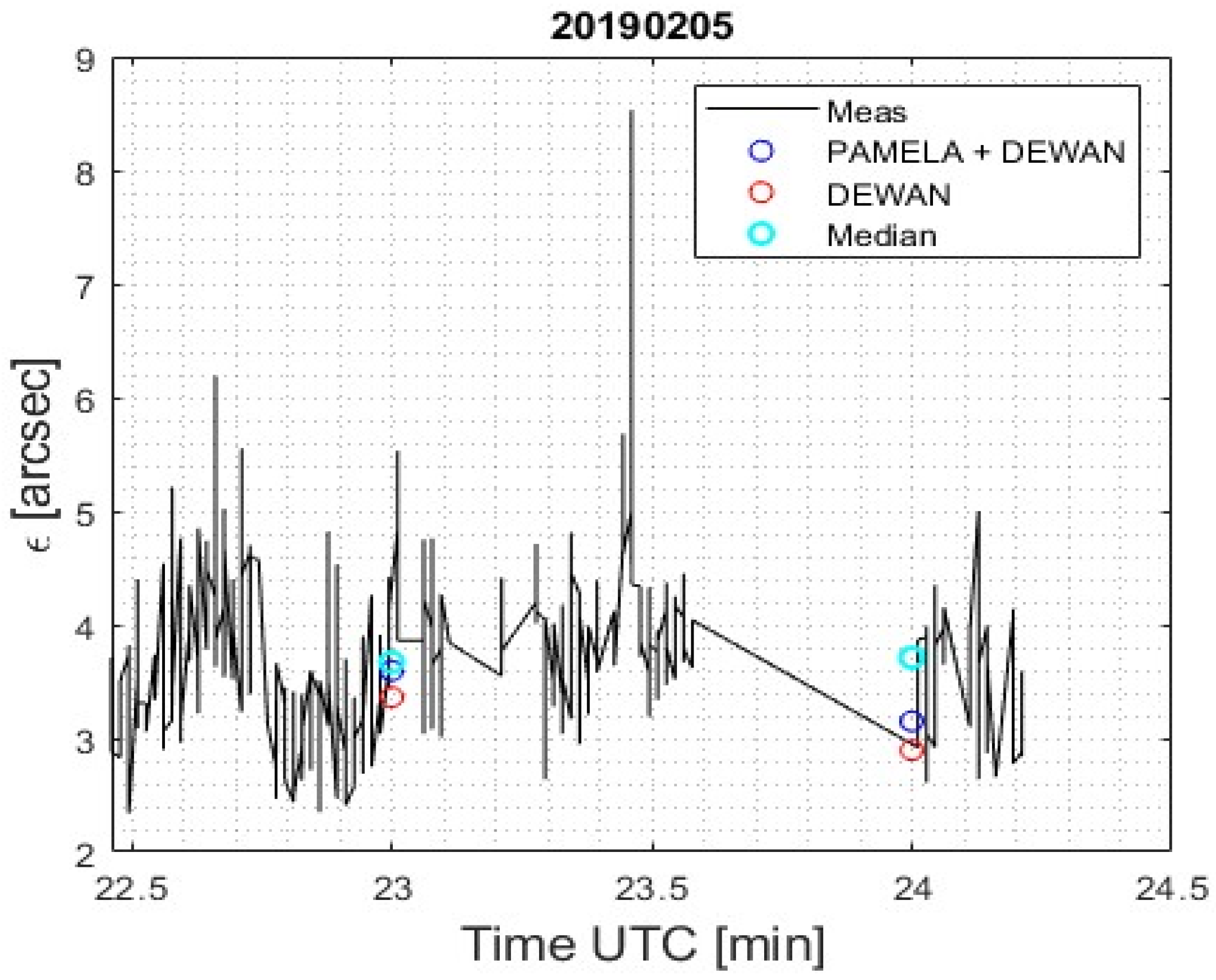
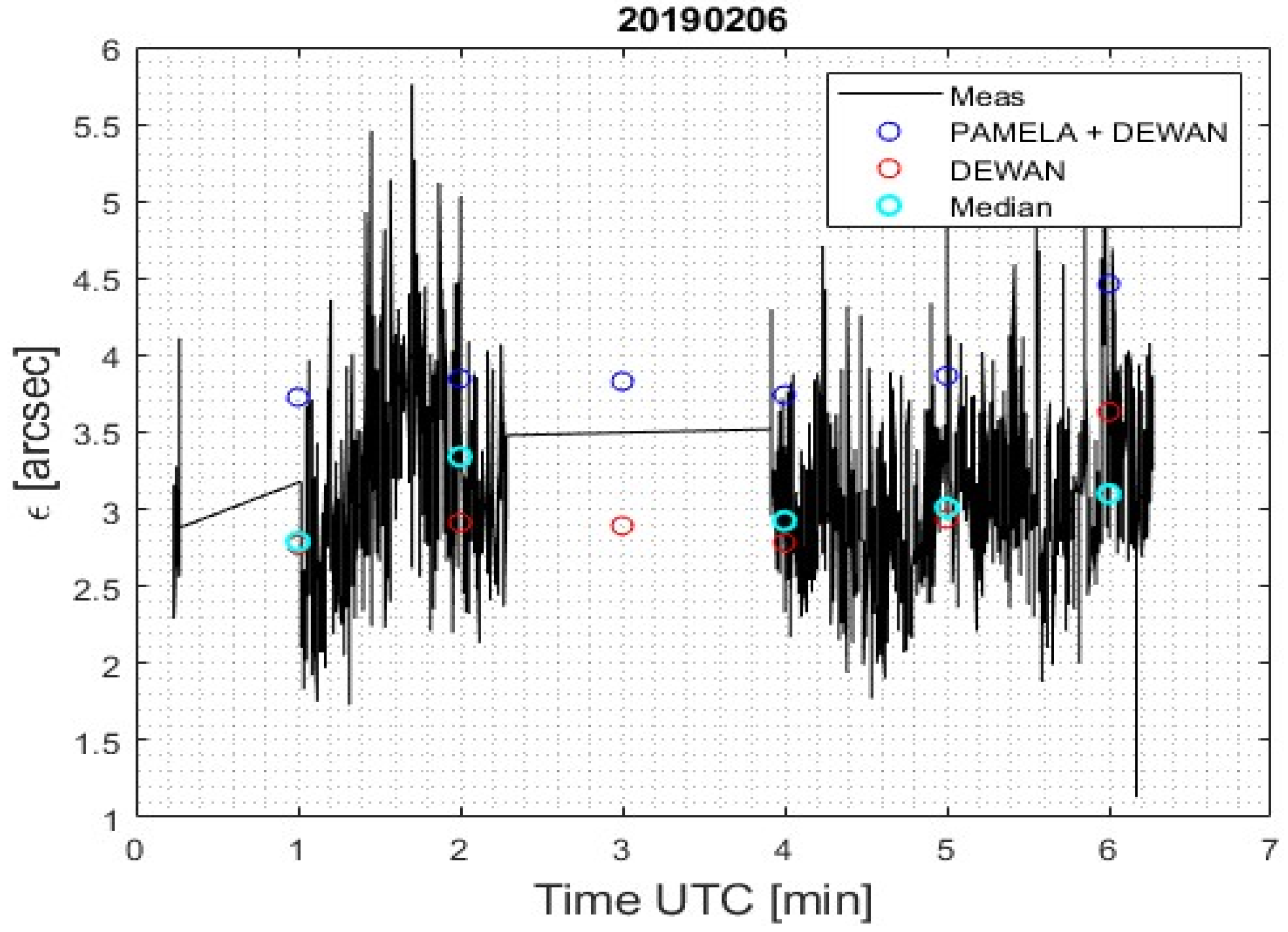

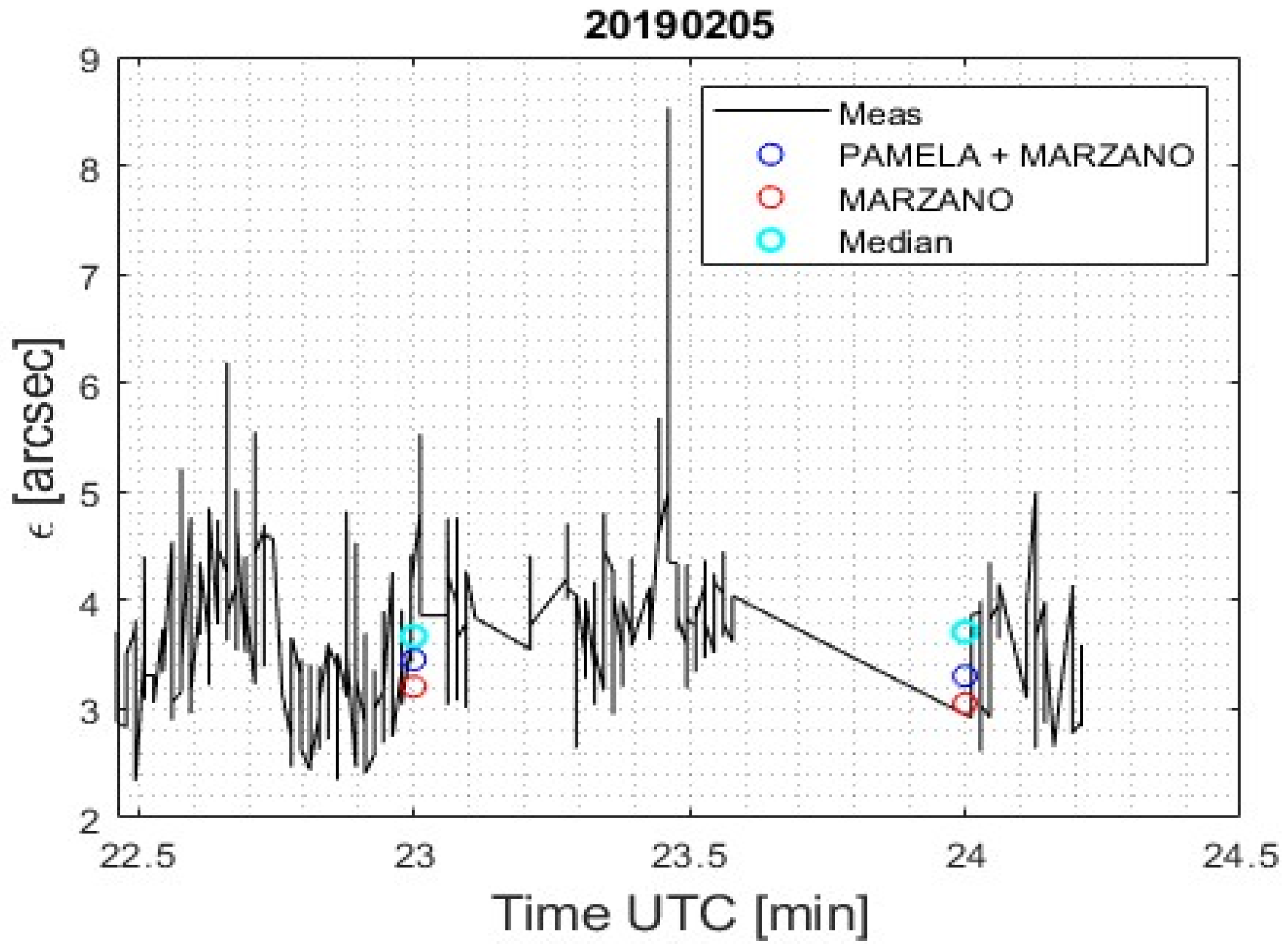
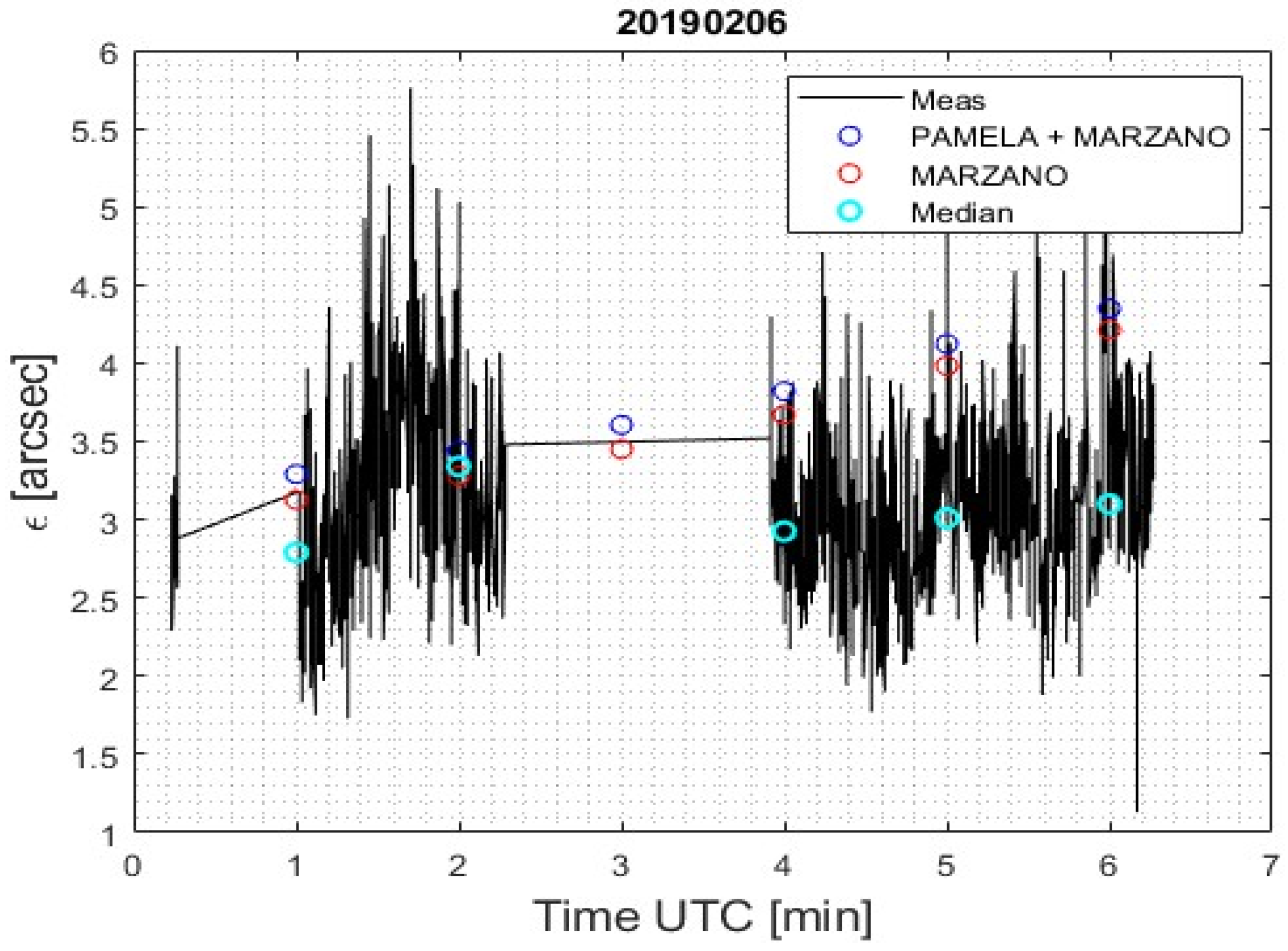
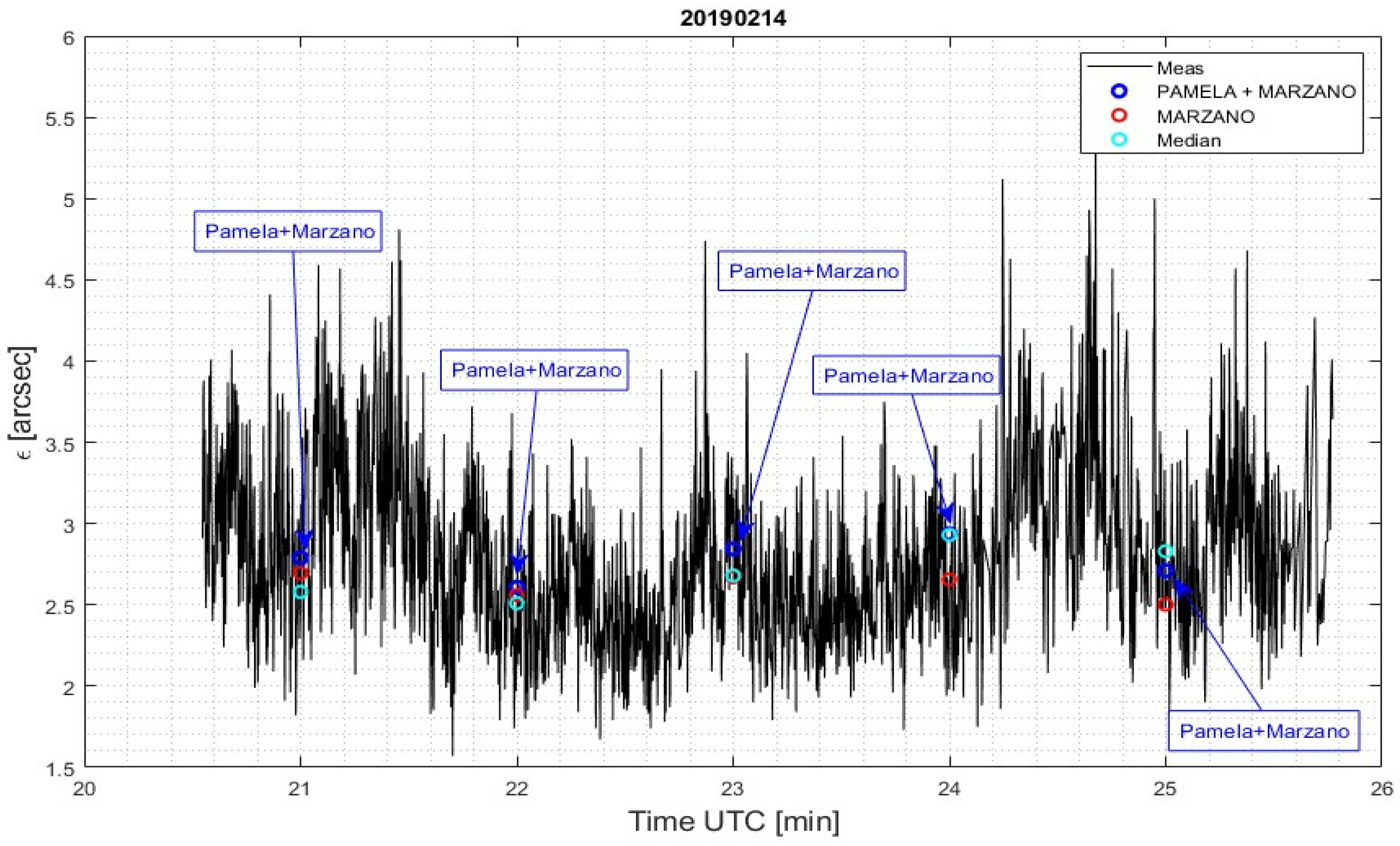
| Altitude (m) | Boundary Layer | Altitude (m) | Free Atmosphere |
|---|---|---|---|
| 5 | 2.8349920 | 1500 | 0.2202239 |
| 55 | 0.7825773 | 2500 | 0.1232994 |
| 105 | 0.2851246 | 3500 | 0.1220847 |
| 155 | 0.2247893 | 4500 | 0.1116992 |
| 205 | 0.2339369 | 5500 | 7.9565063 × 10−2 |
| 255 | 0.2368697 | 6500 | 7.6611020 × 10−2 |
| 305 | 0.1393718 | 7500 | 9.4689481 × 10−2 |
| 355 | 0.1697904 | 8500 | 8.2437001 × 10−2 |
| 405 | 0.1350916 | 9500 | 8.5563779 × 10−2 |
| 455 | 0.1151705 | 10,500 | 7.9648279 × 10−2 |
| 505 | 0.1201656 | 11,500 | 5.9562359 × 10−2 |
| 555 | 0.1242000 | 12,500 | 4.4496831 × 10−2 |
| 605 | 0.1528365 | 13,500 | 4.5322943 × 10−2 |
| 655 | 0.1258108 | 14,500 | 3.8577948 × 10−2 |
| 705 | 0.1038473 | 15,500 | 4.9237989 × 10−2 |
| 755 | 9.6003376 × 10−2 | 16,500 | 4.5535788 × 10−2 |
| 805 | 8.3205506 × 10−2 | 17,500 | 4.5892496 × 10−2 |
| 855 | 0.1061958 | 18,500 | 3.9653547 × 10−2 |
| 905 | 9.4715632 × 10−2 | 19,500 | 4.1269500 × 10−2 |
| 955 | 0.1022552 |
| Surface Type | Roughness Length (cm) |
|---|---|
| Village | 40 |
| Town | 55 |
| Light-density residential | 108 |
| Park | 127 |
| Office | 175 |
| Central business district | 321 |
| Heavy density residential | 370 |
| Grass (5–6 cm) | 0.75 |
| Alfalfa | 2.7 |
| Long grass | 3 |
| Grass (60–70 cm) | 11.4 |
| Open brush or scrub | 16 |
| Wheat | 22 |
| Dense brush or scrub | 25 |
| Forest clearing or cutovers | 32–48 |
| Corn | 74 |
| Coniferous forest | 110 |
| Citrus orchard | 198 |
| Fir forest | 283 |
Disclaimer/Publisher’s Note: The statements, opinions and data contained in all publications are solely those of the individual author(s) and contributor(s) and not of MDPI and/or the editor(s). MDPI and/or the editor(s) disclaim responsibility for any injury to people or property resulting from any ideas, methods, instructions or products referred to in the content. |
© 2023 by the authors. Licensee MDPI, Basel, Switzerland. This article is an open access article distributed under the terms and conditions of the Creative Commons Attribution (CC BY) license (https://creativecommons.org/licenses/by/4.0/).
Share and Cite
Bekhrad, P.; Leitgeb, E.; Ivanov, H. A Multifaceted Exploration of Atmospheric Turbulence and Its Impact on Optical Systems: Structure Constant Profiles and Astronomical Seeing. Electronics 2024, 13, 55. https://doi.org/10.3390/electronics13010055
Bekhrad P, Leitgeb E, Ivanov H. A Multifaceted Exploration of Atmospheric Turbulence and Its Impact on Optical Systems: Structure Constant Profiles and Astronomical Seeing. Electronics. 2024; 13(1):55. https://doi.org/10.3390/electronics13010055
Chicago/Turabian StyleBekhrad, Pasha, Erich Leitgeb, and Hristo Ivanov. 2024. "A Multifaceted Exploration of Atmospheric Turbulence and Its Impact on Optical Systems: Structure Constant Profiles and Astronomical Seeing" Electronics 13, no. 1: 55. https://doi.org/10.3390/electronics13010055







